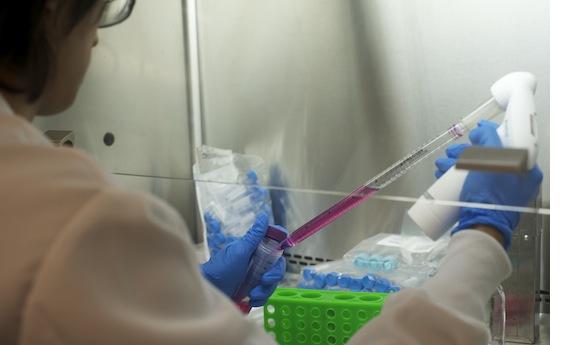At Krasnow Institute, students conduct high-profile research
The Krasnow Institute for Advanced Study is not easy to find.
Nestled away at the very edge of the Mason Fairfax campus, on a small side street off Shenandoah Lane, the institute looks indistinguishable from any other university building.
Inside, students labor over homework in the Great Room, a high-ceilinged library complete with a fireplace, and hunch over microscopes in the many labs.
Posters cover the hallway walls, displaying graphs, charts and titles like “Communication Development of Autism Spectrum Disorder Through a Behavior-Level Approach.”
Although technically an academic unit similar to the College of Science, the Krasnow Institute is a premiere research facility. The institute’s faculty prepares aspiring scientists for the future and seek innovative ways to expand the boundaries of scientific understanding.
“Student projects include anything high-risk, high-pay-off in science,” said Dr. James Olds, Ph.D., director and chief academic unit officer of the Krasnow Institute. “These [projects] are advanced studies in anything leading to an increase in human knowledge, not just a paper but a paradigm shift.”
Olds not only supervises the institution as a whole but also teaches molecular neuroscience and serves as a chair on the department board.
The Krasnow Institute was founded in 1993 by Nobel laureates Murray Gell-Mann and Herbert A. Simon, using a substantial amount of money left by the passing of renowned philanthropist Shelley Krasnow.
In 2002, the Krasnow Institute merged with George Mason University and by 2007, became a full-fledged academic unit.
In addition to its top-notch research capabilities, the Krasnow Institute offers classes in molecular neuroscience and computational social science for both undergraduate and graduate students.
While neuroscience is of particular interest in the institute, research covers a wide range of topics. For example, Margaret Slavin, Ph.D., is an assistant professor in Mason’s Department of Nutrition and Food Studies
“The Neuroscience Department is housed here so research tends to be focused there, but other types are also encouraged, especially collaborative research,” Slavin said.
Over the years, students received millions of dollars in funding from federal agencies and elite private institutions. The National Institutes of Health sponsors the project of Giorgio Ascoli, who aims to create neural networks of mammal brains in hopes of understanding the connection between Alzheimer’s disease and memory loss.
Another project, conducted by Harold Morowitz and centered on the origin of life, is sponsored by the National Science Foundation Frontiers in Integrative Biological Research grant.
Not all the students are experts, however. For example, Shweta Chaudhary, a senior majoring in biology, just started a research semester at the Krasnow Institute. Chaudhary was unwilling to divulge any specific details about her research because the project is ongoing, but she mentioned that it involves using mice cells to study migraines.
“I wanted to work in a lab,” Chaudhary said. “I wanted to see if I could be a researcher some day. This was a good opportunity for me to get used to being in a lab.”
There are no plans at the moment to expand the Krasnow Institute, as Olds wants to keep collaboration between researchers as easy as possible and limit bureaucracy to a minimum.
Even so, the institute continues to have a major impact on the global scientific community. The institution serves as a national resource for scientists interested in improving humanity’s wellbeing.
“This is one of the nation’s finest examples of trans-disciplinary science,” Olds said. “Students’ careers are transformed by meaningful research.”
This story appeared in the Sept. 9 edition of Fourth Estate Weekly.

